- Home
- Media Kit
- MediaJet
- Current Issue
- Past Issues
- Ad Specs-Submission
- Ad Print Settings
- Reprints (PDF)
- Photo Specifications (PDF)
- Contact Us
![]()
ONLINE
![]()
ONLINE

Leadership in
the 21st Century
Editors’ Note
For a dozen years as Chairman and CEO of PepsiCo, Indra Nooyi was one of the world’s most admired business leaders. The first woman of color and immigrant to lead a Fortune 50 company, she transformed the company with a long-term vision, vigorous pursuit of excellence and a deep sense of purpose. Nooyi is a revered role model who has long spoken up about women, equity, inclusion and evolving the global economy to support families. My Life in Full: Work, Family, and Our Future is her first book. Nooyi was born in Madras (Chennai), Tamil Nadu, India, and grew up in a close family with two siblings, her parents and her grandparents. She earned a bachelor’s degree from Madras Christian College and an MBA from the Indian Institute of Management Calcutta. She began her business career at the textile firm Mettur Beardsell in Madras and as a product manager at Johnson & Johnson in Bombay. In 1978, Nooyi received a scholarship to attend Yale University where she earned a master’s degree in public and private management. She then joined Boston Consulting Group (BCG) as a strategy consultant and, from 1986 to 1994, worked at Motorola and ABB leading corporate strategy and planning departments. Nooyi entered the executive suite at PepsiCo in 1994 and became CFO and then President of the company in 2001. She joined the Board of Directors in 2001 and, five years later, was named Chairman and Chief Executive Officer. Leading PepsiCo, Nooyi was the architect of Performance with Purpose, the company’s pledge to make healthier and more nutritious products, limit the company’s environmental footprint, and empower its associates and people in the communities it serves. At the same time, the company’s net revenue grew 80 percent and market capitalization grew by $57 billion. In her first sustainability report as CEO, she commented, “When I was a child in India, my mother would ask my sister and me a simple but compelling question: ‘What would you do to change the world?’ Today, I know my answer would be that I want to lead a company that is a force for good in the world. A company that delivers strong financial performance, while embracing purpose in everything it does.” Nooyi is now a member of the board of Amazon, where she chairs the audit committee. She sits on the supervisory board of Philips, where she is also a member of the nominating and corporate governance committee. She is a member of the International Advisory Council of Temasek; an independent director of the International Cricket Council; and a member of the American Academy of Arts & Sciences. She is on the Dean’s Advisory Council at MIT’s School of Engineering, and a member of the MIT Corporation. She also serves on the boards of the Memorial Sloan Kettering Cancer Center and the Partnership for Public Service. Additionally, she is the Class of 1951 Chair for the Study of Leadership at West Point where she helps enhance the ability of both the Department of Behavioral Sciences and Leadership and the U.S. Military Academy to fulfill the mission of developing leaders of character. She also serves as an advisor to several early-stage companies. Nooyi has received fifteen honorary degrees. In 2007, the Government of India awarded her the Padma Bhushan, the country’s 3rd highest civilian honor. That same year, she was named an “Outstanding American by Choice” by the U.S. State Department. In 2019, her portrait was inducted into the Smithsonian National Portrait Gallery. In 2021, Nooyi became an elected member of the American Philosophical Society and a trustee of the National Gallery of Art. She was also inducted into the Asian Hall of Fame and National Women’s Hall of Fame.
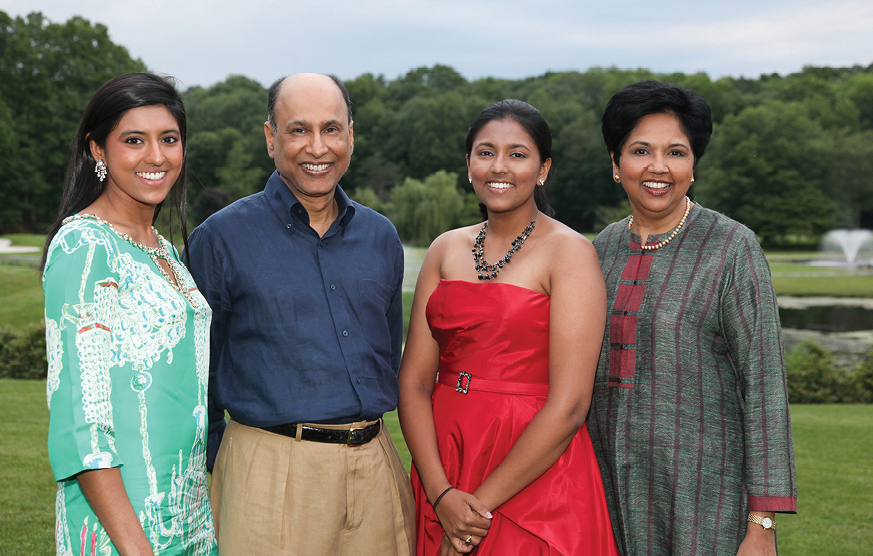
Indra Nooyi with her family
You were the first woman of color and immigrant to run a Fortune 50 company. What were the keys to your success in business and what made you such an effective leader?
Here are my observations based on my collection of experiences over the years: First, stay focused on building the company for the long-term while delivering sensible financial results in the short-term – manage the company for both level and duration of returns. Second, surround yourself with outstanding talent – competent, courageous people who are not political and who speak their mind freely. Provide an environment that encourages honest feedback and discussion. Third, treat all of your employees as valuable assets of the company, not as tools of the trade. Engage them – head, heart and hands. Fourth, get out of the office and talk to your employees, customers, suppliers, etc. in your key regions and countries. Be your own boots on the ground. Sustain connections with them over time. They serve as early signal indicators. Finally, family. My family kept me grounded and reminded me constantly that power and humility have to be kept in balance. They were my biggest supporters and my best critics.
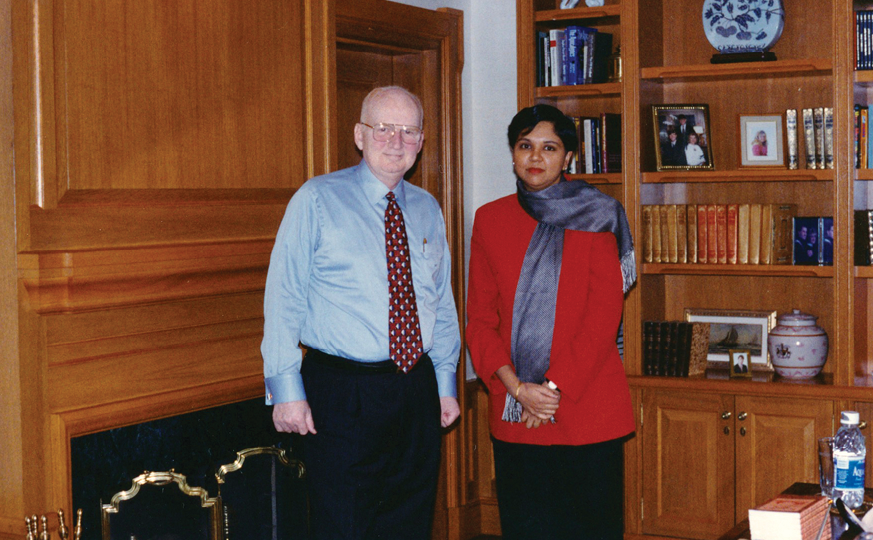
Indra Nooyi with Wayne Calloway,
former Chairman and CEO of PepsiCo
You have said that “Greatness comes not from a position, but from helping build the future. We have an obligation to pull others up.” Is this how you define effective leadership in the 21st century?
Many qualities characterize effective leadership in the 21st century, and they are continuously changing. When I speak about our obligation to “pull others up,” I refer to the fact that a leader’s biggest legacy is to develop the next generation of talent. These individuals need to be identified, nurtured, coached, celebrated and retained to ensure the company remains successful well into the future.
Today, the idea of “Performance with Purpose” is broadly recognized, but when you introduced this idea at PepsiCo, there were many who questioned the concept. Was it challenging to bring people on board early on with this mission and, in retrospect, do you feel that in many ways you were ahead of your time with this concept?
“Performance with Purpose” has been far more revolutionary than I originally anticipated when I came up with it in 2006. At that time, the audience consisted of senior managers, investors, suppliers, customers, and many critics from the public health world. I had to persuade many of them to take this leap with me – to embrace the idea that we could make money a different way, with an eye toward building a healthier product portfolio, taking environmental sustainability seriously, and nurturing talent.
In a way, “Performance with Purpose” was ahead of its time and a precursor to the ESG push we are seeing today. But in my mind, the concept was badly needed. I firmly believed then, as I do now, that companies are a part of society and have a duty of care to the communities they are a part of. I was merely infusing this into our business model. It was a tough sell at first – I was infamously called “Mother Teresa” by one investor – but almost everyone came around. PepsiCo created a lot of shareholder value in my time as CEO and we did that while transforming key parts of the business.
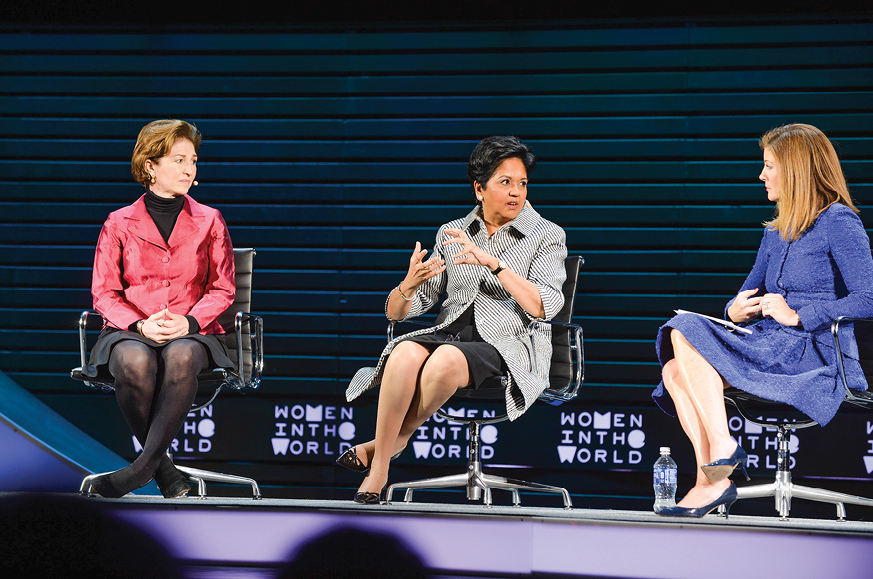
Indra Nooyi at Women in the World event
You placed a major focus on mixing work and home life throughout your leadership at PepsiCo. What made this so important to you and what are the keys to building a company culture that allows the blending of work and family?
Family comes first, plain and simple. The family I created with my husband Raj and two daughters is my proudest achievement. They define me, anchor me, and teach me what love is all about. They are my life.
But as CEO of PepsiCo, I also had to worry about my other family – my 260,000 employees and our customers, suppliers, and many others whose economic well-being depended on the success of the company. I took this job very, very seriously. Both my primary family and my PepsiCo family had to be kept in balance.
It was tough. I was constantly “juggling” the split responsibilities and priorities of my work and family life, and without the advantage of the technology we now have – Zoom, FaceTime, texting, etc. With the advancement of technology and our experience with flexible everything due to the COVID-19 pandemic, we have a unique opportunity to design the future of work, end to end, putting family in the center.
What if parents could meet their kids at home when they return from school and transition to working remotely while their kids are engaged in homework? Could we help working parents design a schedule that accommodates both their job responsibilities and time to care for their families? How do companies create a culture where a focus on family is embraced rather than treated as a separate part of life? And what if companies were to augment these considerations with creative, supportive benefits – like sensible paid leave and affordable, available, quality childcare – for their employees who are also family builders? Defining the future of work with these issues in mind is what will allow companies to attract and retain the best and brightest talent.
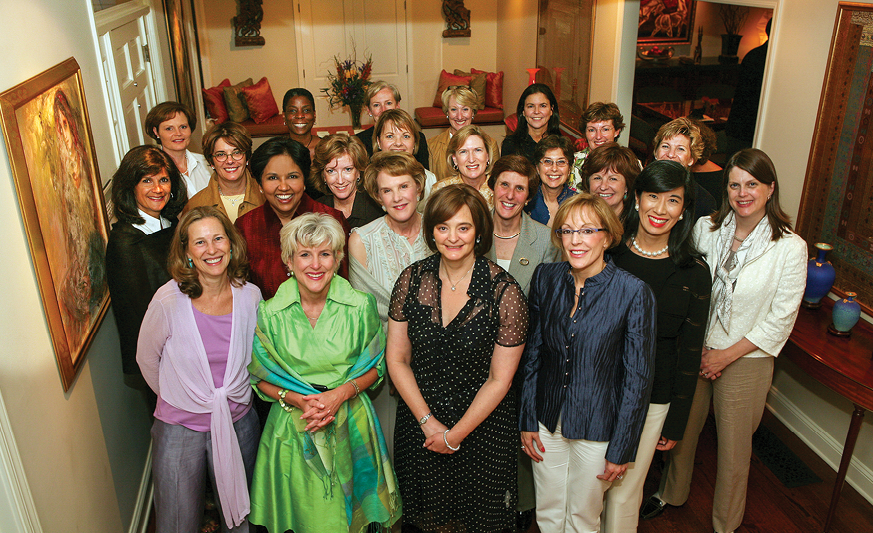
Indra Nooyi with leading women CEOs
PepsiCo was known for a culture of continuous innovation. Is it more challenging to stay innovative at the size and scale of a company such as PepsiCo and how were you able to maintain the innovative edge?
Innovation drives growth. Growth is oxygen for companies. Creating an innovation-forward mindset and putting in place the right capabilities, goals, and incentive structures to encourage innovation are all critical building blocks for any company. Innovation must be approached deliberately and mathematically. Start by mapping out a few key factors. For example, what level of top line growth are you looking for? How much of that growth will come from existing products, from line extensions, and from new platforms: What kind of fall off do you have from existing innovation? What is the net sales number driven by innovation that you must deliver on every year? Work backwards – how can an innovation pipeline be built and moved through various stage gates?
This entire area could be a whole “treatise” on its own, but my key message is this – when a leader talks about innovation, it’s critical that they move from generalities to specifics. Only then can you hold your people accountable and can the company deliver superior growth year after year.
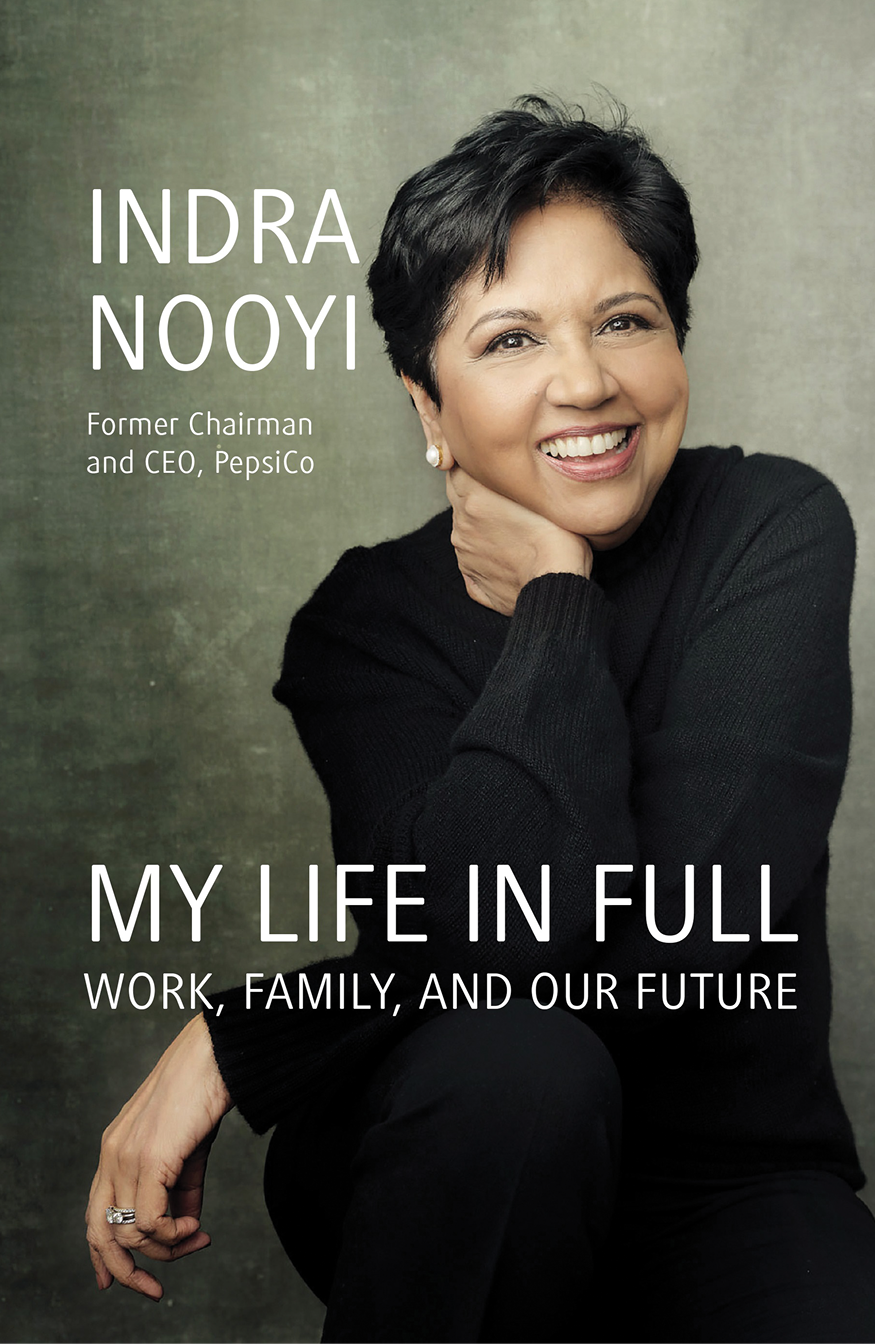
What interested you in writing the book, My Life in Full, and what are the key messages you wanted to convey in the book?
When I retired from PepsiCo, I was adamant that I would never write a memoir. I started off by writing policy papers about how we can make life easier for women managing the competing demands of work and family. But everybody who read my papers said that for my ideas to be memorable, I needed to inform this issue with the story of my own life. I needed to make it personal. My Life in Full is that book. It doubles as a memoir and call-to-action.
There are several key messages in the book, and they all intersect. One is that family is core. We have to elevate it into the global conversation, and not minimize it as a female issue. Another is that women represent an untapped talent pool and empowering them to contribute fully to paid work is important for families, companies, and the economy as a whole. This all comes together to reinforce my moonshot: building a support structure that enables women and family builders to thrive while driving our GDP growth higher.
How critical is it for companies to build diverse and inclusive workforces to mirror the diversity of their customers, clients, and communities?
It is my firm belief that having diverse voices around a table leads to better thinking and better outcomes. Many research studies have proven this. I believe a focus on diversity and inclusion allows a company to draw the best talent from the entire workforce, as opposed to drawing only from a portion of the available pool. With talent being the biggest competitive advantage for any company today, it is critical for leadership to embrace this perspective.
But diversity and inclusion does not happen automatically. It requires diligence. Diversity is a number and inclusion is a mindset, a behavior. You cannot practice inclusion if a company or workforce does not yet have a critical mass of diverse talent.
The first step may require companies to set goals for hiring diverse talent. Only after enough diverse talent is present in the company can you actually model and reinforce inclusive behavior.
Secondly, appointing a DE&I officer can help draw attention to the importance of this topic within a company, but diversity and inclusion has to be the responsibility of the CEO and all senior leaders. It has to be tied to their annual incentives. Without this level of commitment, a focus on diversity and inclusion will struggle to take root in a company.

Indra Nooyi during her last day as CEO of PepsiCo
You have devoted a great deal of time and energy to mentoring young women and supporting the advancement of women in business. Do you feel that progress has been made in this area and what more needs to be done to provide equal opportunities for women to grow and lead in the corporate world?
Seventy percent of highschool valedictorians are girls. Nationwide, girls earn the highest grades in high school, accounting for 60 percent of A or A-plus averages, inclusive of STEM fields. They outnumber men at all the top universities and have higher college graduation rates.
Women are hungry. They want the power of the purse. They want economic freedom.
Yes, some progress has been made with regard to workplace bias, pay parity and other prevalent issues. But we need to do more to help women who want to and have ambitions to balance both work and family. Today, many women enter the workforce with high hopes and dreams and are forced to confront heartbreaking choices: either quit their job to raise a family, delay having a family, or don’t have one at all. All three options are equally worrisome.
As I mentioned before, what if companies provided paid leave, flexible work hours, and access to quality childcare? This could reduce the incredible stress that burdens family builders managing responsibilities both at work and at home and keep them engaged in paid work. What if we designed intelligent return ramps for those who want to take time off to raise a family and eventually return to work? We could re-integrate these highly qualified individuals so they’re not permanently cut off from meaningful, paid work.
Rather than speaking with despair about the Great Resignation, let’s speak with optimism about the Great Retention and the Great Re-Enrollment. The talent is out there. It’s about how we attract, retain, and re-enroll them into the job of nation-building – empowering them to engage in paid work to grow the economy while also building families that will sustain our society over the long-term.
What advice do you offer to young people beginning their careers during this challenging and uncertain time?
We are living in an extraordinary time. The pace of change feels faster. The young people who are diving into their careers have more tools at their disposal than ever before, but they also face a world that is changing rapidly. So, here’s my advice in that context:
First, be a lifelong student – technology is advancing rapidly, and to keep pace, you must have insatiable curiosity and be a life-long learner. That is how you stay relevant and progress.
Second, build strong relationships with mentors. Your mentors pick you, you don’t necessarily pick them, but perform at a level that makes senior leaders want to mentor you. And, when you find that mentor, cultivate that relationship, and take it very seriously – it’s a two-way street.
Finally, whether you’re a corporate leader or a startup founder, remain committed to the job at hand. Don’t focus on where you might be headed next. Deliver on your current responsibilities and priorities and do them to the utmost of your ability – no matter how exciting or onerous. Become irreplaceable.
When you look back at your career, were you able to take moments to celebrate the wins or were you always looking to the future?
I did celebrate the wins, but always had an eye toward the next big challenge. I am wired that way, never content with where I am, always looking to push the boundaries of my work. It was self-generated. This restlessness and desire to keep looking around corners kept me invigorated – although it may have exhausted the people around me.
You are known to be an optimistic person who looks at challenges as opportunities. As you look at the multiple crises facing the world today, from public health to social injustice to climate change, are you optimistic that the world will effectively meet and overcome these challenges?
Many of the issues of the future – pandemics, cybersecurity, talent availability, environmental issues – all require us to work together, globally and across borders. It will require extraordinary collaboration and leadership. I worry about those in power who hold entrenched, extreme views and who refuse to see a brighter, better future for the world. But I am optimistic about the younger generations that will take charge of these issues.
I am optimistic because I see incredible innovation coming from the minds of the youth. I see Gen Z and the Alpha generation coming together, building friendships, generating ideas, and doing it with people across the world, irrespective of race, gender, or ethnicity. We need our young people to ascend to positions of power – particularly in the political arena – so that optimistic thinking can permeate across society. With them at the helm, we will overcome these challenges.![]()